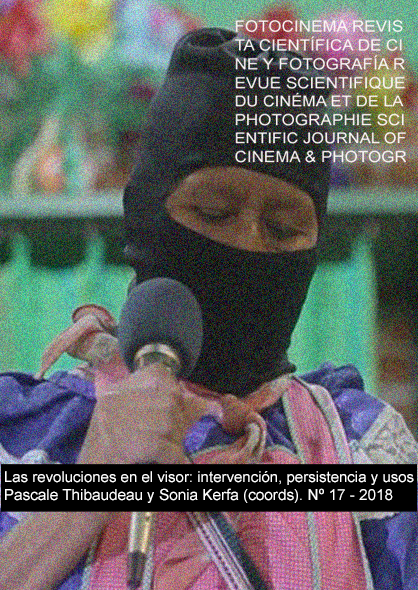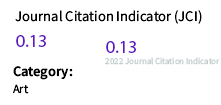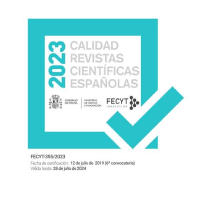The subjective immersion of a phenomenological narration. About Saul’s son (Saul fia, Lászlo Nemes, 2015)
DOI:
https://doi.org/10.24310/Fotocinema.2018.v0i17.5113Keywords:
All-Knowing Narrator, Targeting, Ocularization, Earring, Sequence shot.Abstract
In this work we intend to develop such thorny concepts as the representation of reality through fiction and the discursive mechanisms that make it possible. We have tried to clarify the notion of point of view by an extreme example capable of calling into question the principles managed by previous theoretical reflection when applied to a very singular text: the film by László Nemes Saul’s Son (Saul fia, 2015). Our objective is to apply a series of narratological notions that allow us to reflect the complexity of visual and sound perception from the limitations of the narrator implicit in the subjectivity of the protagonist of Saúl's son.
Downloads
Metrics
References
Benjamin, W. (1978). Sens unique. París: Maurice Nadeu.
Chion, M. (1998). La audiovisión. Introducción a un análisis conjunto de la imagen y el sonido. Barcelona: Paidós. Traducción de Antonio López Ruiz.
Company, J. M., Ferrando García, P. (2013). Theo Angelopoulos, El paso suspendido: punto de encuentro. En El tiempo suspendido. Santander: Revista Shangrila, derivas y ficciones aparte, números 18-19, diciembre, 116-129.
Didi-Huberman, G. (2004). Imágenes pese a todo. Memoria visual del Holocausto. Barcelona: Paidós. Traducción Mariana Miracle.
Didi-Huberman, G. (2016). El hijo de Saúl. Salir de la oscuridad. Caimán cuadernos de cine, 45 (96), 20. Traducción de Natalia Ruiz.
Ferrando García, P., Moral Martín. J. (2017). Antes y después de Auschwitz. La cinta blanca y La cuestión humana. Santander: Shangrila Ediciones.
Gaudreault, A., Jost, F. (1995). El relato cinematográfico. Cine y narratología. Barcelona: Paidós. Traducción de Nuria Pujol.
Girona, N. (2016). Si esto es un padre. El hijo de Saúl. Lázló Nemes, 2015. Ética y Cine Journal, Vol. 6, Nª 3.
Gómez-Tarín, F.J. (2010). El análisis de textos audiovisuales. Significación y Sentido. Santander: Shangrila Ediciones.
Gómez-Tarín, F.J. (2011). Elementos de Narrativa Audiovisual. Expresión y Narración. Santander: Shangrila Ediciones.
Heredero, C.F. (2016). El hijo de Saúl. Làszlo Nemes. La resistencia moral. Caimán cuadernos de cine nº 45 (96).
Pena, J. (2016). Entrevista László Nemes. Viaje al corazón de la muerte. Caimán cuadernos de cine nº 45 (96).
Wajcman, G. (2001). El objeto del siglo. Buenos Aires: Amorrortu.
Zizek, S. (2006). Lacrimae Rerum. Ensayos sobre cine moderno y ciberespacio. Barcelona: Debate. Traducción de Ramón Vilà Vernis.
Downloads
Additional Files
Published
How to Cite
Issue
Section
License
All contents published in Fotocinema Revista científica de cine y fotografía are protected under the Creative Commons Attribution-NonCommercial-ShareAlike 4.0 International (CC BY-NC-SA 4.0) license. All about this license is available in the following link: <http://creativecommons.org/licenses/by-nc-sa/4.0>
Users can copy, use, redistribute, share and exhibit publicly as long as:
- The original source and authorship of the material are cited (Journal, Publisher and URL of the work).
- It is not used for comercial purposes.
- The existence of the license and its especifications are mentioned.
There are two sets of authors’ rights: moral and property rights. Moral rights are perpetual prerogatives, unrenounceable, not-transferable, unalienable, imprescriptible and inembargable. According to authors’ rights legislation, Fotocinema. Revista científica de cine y fotografía recognizes and respects authors moral rights, as well as the ownership of property rights, which will be transferred to University of Malaga in open access. The property rights are referred to the benefits that are gained by the use or the dissemination of works. Fotocinema. Revista científica de cine y fotografía is published in an open access form and it is exclusively licenced by any means for doing or authorising distribution, dissemination, reproduction, , adaptation, translation or arrangement of works.
Authors are responsable for obtaining the necessary permission to use copyrighted images.










.png)

13.png)




